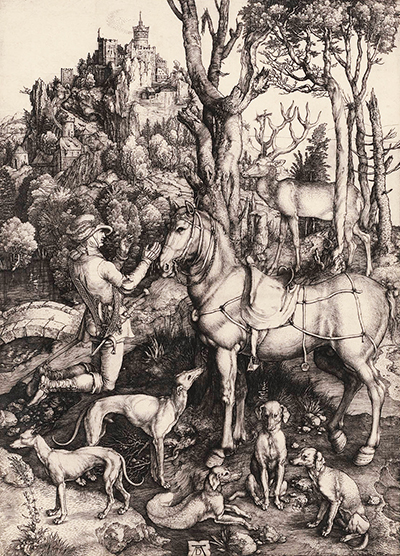The St. Eustace is an engraving on paper created by the German Renaissance artist Albrecht Dürer ca. 1501. The dimensions of the engraving are 35.4 x 26 cm (or 13 15/16 x 10 1/4 inches), and it was one of the biggest copper engravings that Dürer ever created.
The St. Eustace can be viewed as part of the Royal Collection, which is managed by the Royal Collection Trust, at Buckingham Palace, London, UK. The engraving shows Saint Eustace, who was once a Roman commander called Placidus, kneeling before a large stag that he had been tracking and hunting earlier. Once Placidus caught up to and cornered the stag, he was surprised to see that the beast had a large crucifix lodged between its antlers. The stag then speaks to Placidus in Jesus Christ's voice, and immediately he kneels in both awe and astonishment. This religious experience had such a profound effect on Placidus that he converted to Christianity and changed his name to Eustace.
What is significant in the engraving is Eustace encircled by an assortment of fauna and flora in a fairytale-like landscape. What is also interesting is how Dürer has paid particular consideration to the dogs, displayed in five different poses, and how he has provided his monogram shown in the centre at the bottom on a piece of paper. Eustace eventually became a member of the Fourteen Holy Helpers, who were a religious group of saints who were the subject of much reverence and adoration in Germany. The Fourteen Holy Helpers were renown for praying for those who were gravely ill, and who subsequently and miraculously were restored to full health.
This engraving is somewhat similar to the Italian artist Pisanello’s painting titled The Vision of Saint Eustace, and it is extremely likely that Dürer had come across his painting during one of his many sojourns to Italy and had gained inspiration from it. Albrecht Dürer was deemed one of the leading artists of the Renaissance period, and his extensive work in printmaking altered both the importance and notoriety of the craft. Despite his self-portraits, the subjects of Dürer’s work were often religious topics and noble religious figures, which belies his own faith which he held dear to himself. Over time his skill and artistic judgement became so profound that he was offered, and accepted, the role of court artist for both Roman Emperors Maximilian I and Charles V. During his time in this role he created a multitude of both paintings and engravings.




